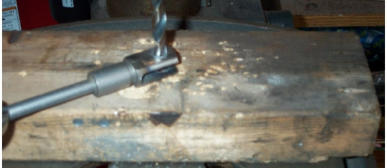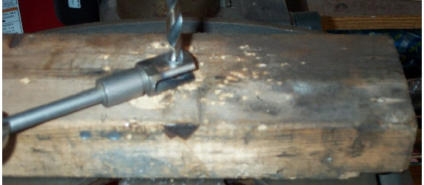



© 2018-2025 - Macy’s Garage, Ltd.
Macy’s Garage

America’s BEST Triumph Shop
M-CYL PUSH RODS
Master Cylinder Push Rods
Quite often we get cars here with worn-out holes in the brake and clutch master cylinder clevis forks. This condition also happens to the tops of the pedals (especially the clutch pedal), and down at the clutch slave cylinder push rod clevis. This example is an early TR3 with the TR2 style Lockheed brakes, and these parts are not available from any of the usual sources, so they had to be repaired in-house. The clutch push rod gets more use, and will be worn more than the brake push rod, same with the top of the pedals. If yours aren't worn too badly, you can always install the better of the two push rods on the clutch side and get a several more years of use before you need to repair as shown here. Sorry, but the clutch and brake pedals are not interchangeable! There are several different ways to repair the worn holes, although all will require welding. For the pushrod on the left in Photo #2, we cut a small piece of 3/8” steel brake line that had the correct inside diameter (5/16”) for the pin that attaches the push rod to the pedal. To repair the push rod on the right, the holes will be welded completely closed. A piece of copper pipe was crushed in a vise until it would slip in between the push rod forks to “back- stop” the MIG weld to facilitate this. The MIG welder does not stick to the copper, and this also leaves a nice flat surface on the inside when the holes are welded closed. Photo #3 shows the two push rods after welding, with the steel sleeve attached to the first one, and the holes completely closed on the second. In photo #4, you see that we used a bench grinder to clean up the welds on the outside of both push rods. Once most of the weld is smooth, finish up with a hand file to remove the rough grinding marks. To be able to slip the pedal into position, the steel tube must be cut from between the two forks of the first push rod. In Photo #5 you can see that we’ve cut this away with a band saw, but you could also hold the push rod in a vise and cut the tubing with a hacksaw or a cut-off wheel, leaving 2 thin steel sleeves in the center of the worn pushrod holes. Now we’re ready to drill the new holes for the clevis pins. For the push rod that was completely welded shut, we drilled the new holes in three steps, starting with 1/8”, and working our way up to the required 5/16” I.D. The holes in the tube sleeves of the other push rod were also cleaned up with the 5/16” drill bit. (Photo #6) Photo #7 shows the repaired master cylinder push rods back on the car, and ready for another 60+ years! If the top holes in your pedals were worn so that the clevis pins allowed any slop or free play, drop the pedals out and weld up the holes, then re-drill to 5/16” to eliminate all of the lost motion.











© 2018-2025 - Macy’s Garage, Ltd.
Macy’s Garage


America’s BEST Triumph Shop

M-Cyl. Push Rods
Quite often we get cars here with worn-out holes in the brake and clutch master cylinder clevis forks. This condition also happens to the tops of the pedals (especially the clutch pedal), and down at the clutch slave cylinder push rod clevis. This example is an early TR3 with the TR2 style Lockheed brakes, and these parts are not available from any of the usual sources, so they had to be repaired in-house. The clutch push rod gets more use, and will be worn more than the brake push rod, same with the top of the pedals. If yours aren't worn too badly, you can always install the better of the two push rods on the clutch side and get a several more years of use before you need to repair as shown here. Sorry, but the clutch and brake pedals are not interchangeable! There are several different ways to repair the worn holes, although all will require welding. For the pushrod on the left in Photo #2 above, we cut a small piece of 3/8” steel brake line that had the correct inside diameter (5/16”) for the pin that attaches the push rod to the pedal. To repair the push rod on the right, the holes will be welded completely closed. A piece of copper pipe was crushed in a vise until it would slip in between the push rod forks to “back-stop” the MIG weld to facilitate this. The MIG welder does not stick to the copper, and this also leaves a nice flat surface on the inside when the holes are welded closed. Photo #3 shows the two push rods after welding, with the steel sleeve attached to the first one, and the holes completely closed on the second. In photo #4, you see that we used a bench grinder to clean up the welds on the outside of both push rods. Once most of the weld is smooth, finish up with a hand file to remove the rough grinding marks. To be able to slip the pedal into position, the steel tube must be cut from between the two forks of the first push rod. In Photo #5 you can see that we’ve cut this away with a band saw, but you could also hold the push rod in a vise and cut the tubing with a hacksaw or a cut-off wheel, leaving 2 thin steel sleeves in the center of the worn pushrod holes. Now we’re ready to drill the new holes for the clevis pins. For the push rod that was completely welded shut, we drilled the new holes in three steps, starting with 1/8”, and working our way up to the required 5/16” I.D. The holes in the tube sleeves of the other push rod were also cleaned up with the 5/16” drill bit. (Photo #6) Photo #7 shows the repaired master cylinder push rods back on the car, and ready for another 60 +years! If the top holes in your pedals were worn so that the clevis pins allowed any slop or free play, drop the pedals out and weld up the holes, then re-drill to 5/16” to eliminate all of the lost motion.

























